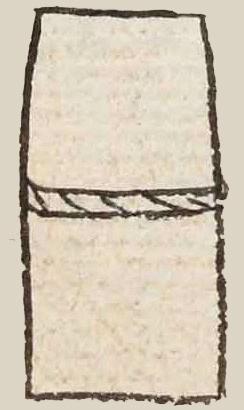amatl (Mdz24v)
This element has been digitally carved from the compound sign for the place name, Itzamatitlan. It is a rolled piece of white paper (amatl) with a tie around the middle.
Stephanie Wood
The paper in this glyph appears pristine and ready for the various purposes for which paper was used (codices, stoles, loincloths, paper hair, paper flags, paper wings and other cuttings for ceremonies, paper for splattering with liquid rubber or blood, wrappers for the dead, etc.). If of the pre-contact type, it was made from the bark of a ficus tree. In the tribute lists, such as on folio 23 verso, a roll of paper much like this is said to be paper native to Mexico, and therefore amatl, not European paper. It is difficult to tell how long the paper roll is, but it was tied to retain the roll shape and protect it until it was ready for use. As shown in our online Nahuatl Dictionary, the Florentine Codex speaks of a white piece of paper that was "a finger thick, a fathom wide, and twenty fathoms long." As an example, the Huexotzinco Codex, currently housed in the Library of Congress collections and created in Spanish colonial Mexico in the sixteenth century, was painted on amatl, as was the Codex Boturini, among others. If the bark paper came out dark, it was sometimes whitewashed. Some amatl was colored, as the yellow example in the Codex Mendoza shows.
Stephanie Wood
Stephanie Wood
c. 1541, but by 1553 at the latest
Stephanie Wood
papers

ama(tl), paper, https://nahuatl.wired-humanities.org/content/amatl
paper
el papel de amate
Stephanie Wood
Codex Mendoza, folio 24 verso, https://digital.bodleian.ox.ac.uk/objects/2fea788e-2aa2-4f08-b6d9-648c00..., image 59 of 188.
The Bodleian Libraries, University of Oxford, hold the original manuscript, the MS. Arch. Selden. A. 1. This image is published here under the UK Creative Commons, “Attribution-NonCommercial-ShareAlike 3.0 License” (CC-BY-NC-SA 3.0).


